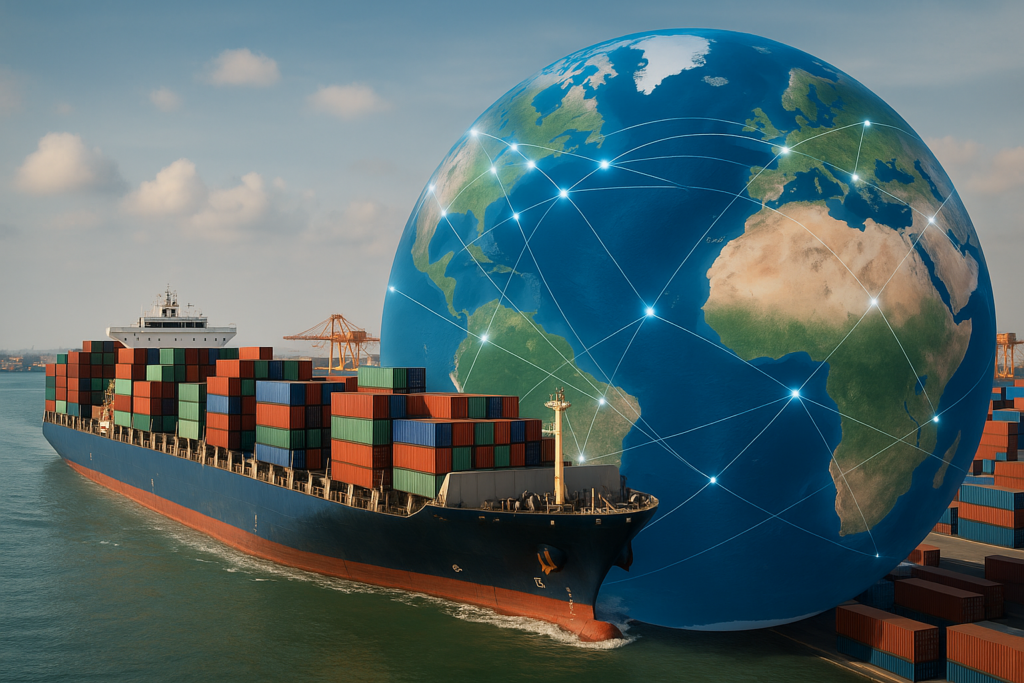
When Global Trade Collides with Your Mortgage
For decades, the U.S. economy has benefited from a massive global shopping spree —
importing affordable goods from countries like China, while exporting fewer in return.
This imbalance, known as a trade deficit, has fueled consumer lifestyles, kept inflation in
check, and attracted foreign investment back into American assets like bonds, stocks,
and real estate. But what happens when the shopping spree comes to a sudden halt?
Imagine slamming the brakes on decades of easy trade. A sudden global trade war —
with tariffs, retaliation, and fractured supply chains — wouldn’t just raise prices at the
store. It would send shockwaves through sectors you might not expect, including the
housing market. From rising construction costs to shaken consumer confidence and
higher mortgage rates, the ripple effects could reshape how — and where — Americans
live.
In this article, we’ll explore how the U.S.’s long-standing trade deficit evolved, how it
quietly supported sectors like housing, and what could happen if that balance suddenly
breaks in a full-scale trade war.

The Great Global Shopping Spree:
Why Buying from China Means They Buy Our Stuff
Imagine you love buying toys made in China. You spend $100 on them. That $100 goes to a Chinese company. Now, what does that Chinese company do with those US dollars? They can’t really use them directly to pay their workers in Chinese currency (RMB) or buy materials in China.
This is where the “invisible hand” of international finance comes in. Think of it like this: The US is on a Big Shopping Spree from China: We buy a lot more goods from China than China buys from us. This creates a trade deficit for the US with China – we owe them more money than they owe us for goods. China Ends Up with a Pile of US Dollars: Because we buy so much from them, Chinese companies and the Chinese government end up holding a large amount of US dollars.
What Can China Do With All These Dollars?
They have a few main choices:
1. Buy American Goods and Services: If they use those dollars to buy things made in the USA, it would balance out the trade. But, as we said, they currently don’t buy as much from us as we buy from them.
2. Hold onto the Dollars: They could just keep the dollars as cash. But like keeping a big pile of any currency under your mattress, it doesn’t really grow or do much.
3. Invest the Dollars: This is the most common and important thing they do. To make their dollars work for them, China needs to invest them somewhere. A safe and reliable place to invest a lot of money is in US bonds.
What are US Bonds? Think of them as IOUs from the US government. When China buys a US bond, they are essentially lending money to the US government. The US government promises to pay them back with interest in the future.
Why US Bonds? The US bond market is huge and considered very safe. When you have a massive amount of money to invest, you need a market that can handle it without big swings in value. US bonds fit that bill.
4. Other US Investments: Besides bonds, China can also invest in other US assets, like:
–Stocks of American Companies: Buying shares in companies like Apple or Microsoft.
– Real Estate: Purchasing buildings or land in the US.
– Other Financial Assets: Various other types of investments available in the US.
The Balancing Act:
So, because the US has a large trade deficit with China (we buy more from them), China ends up with a surplus of US dollars. To manage these dollars effectively and safely, they often invest a significant portion of them in US assets, particularly US bonds. It’s like this: If you keep buying lots of things from your friend, and they don’t buy much from you, they’ll end up with a lot of your money. They can’t really use your money in their own world directly, so they might decide to lend some of it back to you (by buying your bonds) or invest in things in your world.
Important takeaway: A large trade deficit doesn’t mean the money just disappears. It often flows back into the country with the deficit as investments, like China buying US bonds. This is a simplified view, but it helps explain the basic relationship between a trade deficit and international investment.
The Long Shopping Spree:
Peeling Back the Layers of America’s Trade Deficit
For the past three decades, the US has consistently bought more goods from countries like China, Mexico, Japan and other developing nations than it has sold to them, resulting in a long-term trade deficit. This has had both advantages and disadvantages for the American economy. Let’s break it down in simple terms:
The “Good” Side (Potential Advantages):
1. Cheaper Goods for Consumers: Think about where many of your clothes, electronics, and household items are made. Often, it’s in countries with lower labor costs. This allows American retailers to sell these goods at lower prices, stretching your dollar further and increasing your purchasing power. You can buy more for the same amount of money.
2. Lower Inflation: The influx of cheaper imported goods can help keep inflation in check. If American companies had to produce everything domestically, the prices of many goods might be significantly higher.
3. Focus on Innovation and Higher-Value Industries: Some argue that the trade deficit allows the US to focus on industries where it has a competitive advantage, such as technology, services (like finance and entertainment), and high-end manufacturing. By importing simpler goods, the US can dedicate its resources to more innovative and higher-paying sectors.
4. Access to a Wider Variety of Goods: International trade allows American consumers to access a vast array of products that might not be produced domestically.
The “Not So Good” Side (Potential Disadvantages):
1. Job Losses in Manufacturing: As American companies move production to countries with lower labor costs, jobs in the US manufacturing sector can be lost. This can lead to economic hardship for affected communities and workers.
2. Increased National Debt (Potentially): As we discussed, the dollars China
earns from the trade surplus often flow back into the US as investments, particularly in US bonds (IOUs from the government). While this helps finance the US debt, it also means that a significant portion of US debt is held by foreign entities.
3. Dependence on Foreign Supply Chains: A long-term trade deficit can create a reliance on other countries for essential goods. This can become a problem during geopolitical tensions or global disruptions (like a pandemic), potentially leading to shortages and supply chain vulnerabilities.
4. Currency Manipulation Concerns: Some argue that countries with large trade surpluses might intentionally keep their currency value lower to make their exports cheaper. This can make it harder for American companies to compete both domestically and internationally.
5. Loss of Technological Edge (Potentially): If manufacturing and production knowledge moves primarily to other countries, there’s a risk that the US could lose its edge in certain technological and industrial sectors over the long term.
6. Impact on Wages: Increased competition from lower-wage countries can put downward pressure on wages for some American workers, particularly in sectors that compete directly with imports.
The Big Picture:
The long-term effects of a trade deficit are complex and debated by economists. Some argue that as long as the US economy remains strong and attracts foreign investment, a trade deficit isn’t necessarily a bad thing. It can be a sign of strong consumer demand. However, others worry about the long-term consequences of relying heavily on imports, the potential for job losses in key sectors, and the increasing levels of foreign-held US debt. Think of it like constantly buying more from the store than you sell at your own lemonade stand. You get lots of goods, but you’re also accumulating debt to the store owner. If this goes on for a very long time, you might become very dependent on that store, and the store owner might have significant influence over you.
Ultimately, the sustainability and overall impact of a long-term trade deficit depend on various factors, including the health of the global economy, the types of goods being traded, and how the resulting capital flows are managed and invested. It’s a balancing act with potential benefits for consumers in the short term but potential risks for domestic industries and long-term economic security.
The Global Showdown:
What Happens When the US Suddenly Fights a Trade War?
After decades of running trade deficits with countries around the world, including China, Mexico, and Japan, a sudden, large-scale trade war initiated by the US would likely send significant shockwaves through the American economy. It’s like suddenly slamming on the brakes after a long, comfortable drive – things could get very bumpy.
Here’s a breakdown of the potential effects, both good and bad:
The (Potentially) “Good” – A Nationalist Push:
- Boost to Domestic Industries (in theory): The primary goal of a trade war is often to protect domestic industries. By imposing high tariffs (taxes on imports), the US would make foreign goods more expensive, potentially encouraging American consumers and businesses to buy domestically produced goods. This could lead to increased demand for US-made products and potentially create some jobs in those sectors.
- Increased Government Revenue (initially): Tariffs are a form of tax on imports. In the short term, the US government would collect more revenue from these tariffs. However, this is often offset by other economic costs. For example, tariffs necessarily increase prices for consumer goods. An increase in across-the-board prices means that consumers will buy less, therefore directly decreasing the government’s revenue from tariffs, while pushing the US economy towards recession due to decreased spending and consumer confidence.
- Reduced Dependence (long-term goal): Over a longer period, a successful trade war (a big “if”) might lead to a decrease in the US reliance on foreign supply chains, making the economy more resilient to global disruptions.
The Definitely “Bad” – Economic Pain and Disruption:
- Higher Prices for Consumers: American consumers would likely face significantly higher prices for a wide range of goods, from electronics and clothing to cars and food ingredients. This is because imported goods would become more expensive due to tariffs, and even domestic producers might raise prices knowing they face less foreign competition. This would reduce purchasing power and potentially lead to lower living standards.
- Damage to Export Industries: Other countries would almost certainly retaliate with their own tariffs on US exports. This would make American goods more expensive in foreign markets, leading to decreased sales and harming US export-oriented industries like agriculture, aerospace, and certain manufactured goods. This could lead to job losses in these sectors.
- Supply Chain Chaos: After years of relying on complex global supply chains for efficiency and cost-effectiveness, a sudden trade war would disrupt these networks. American businesses that rely on imported components or raw materials would face higher costs, delays, and potential shortages, impacting their production and competitiveness.
- Reduced Business Investment: The uncertainty and increased costs associated with a trade war would likely deter businesses from investing in new equipment, expansions, and hiring. This would stifle economic growth.
- Stock Market Volatility and Potential Decline: The increased economic uncertainty and negative impacts on corporate profits would likely lead to significant volatility and potentially a decline in the stock market, affecting Americans’ investments and retirement savings.
- Inflationary Pressures: The combination of higher import prices and potential disruptions to domestic production could lead to a significant increase in inflation, further eroding consumers’ purchasing power.
- Damage to International Relationships: Initiating a trade war against the entire world would severely strain diplomatic and economic relationships with key trading partners, potentially leading to long-term distrust and hindering future cooperation on other global issues.
- Job Losses Beyond Manufacturing: While some manufacturing jobs might be created (though this is not guaranteed and often offset by automation), job losses in other sectors like retail, transportation, and industries that rely on imports would likely occur due to decreased consumer spending and business activity.
- Reversal of Benefits from Past Trade: The advantages of lower prices and wider variety of goods that American consumers have enjoyed due to the long-term trade deficit would be quickly reversed.
Want to Understand the Bigger Picture?
Global trade plays a crucial role in shaping real estate trends, interest rates, and even home values.
👉 To learn more about how global trade impacts our economy and housing market, check out this YouTube video.
Think of it like this: Imagine your town has gotten used to buying cheap food from neighboring towns. Suddenly, you decide to put a huge tax on all food coming in. Your local farmers might sell a bit more, but everyone in your town will have to pay much higher prices for groceries, and the towns you taxed will likely stop buying your town’s specialty goods in return, hurting your local producers of those items. Your town might become more “self-sufficient” in food, but everyone will be poorer and the relationships with your neighbors will be strained.
In conclusion, while a sudden, global trade war might have the theoretical benefit of boosting some domestic industries and reducing reliance on foreign supply chains in the very long run, the immediate and likely long-term effects on the US economy after decades of trade deficits would be overwhelmingly negative. American consumers would face higher prices, export industries would suffer, supply chains would be disrupted, investment would likely decline, and international relationships would be damaged, leading to significant economic pain and uncertainty.

